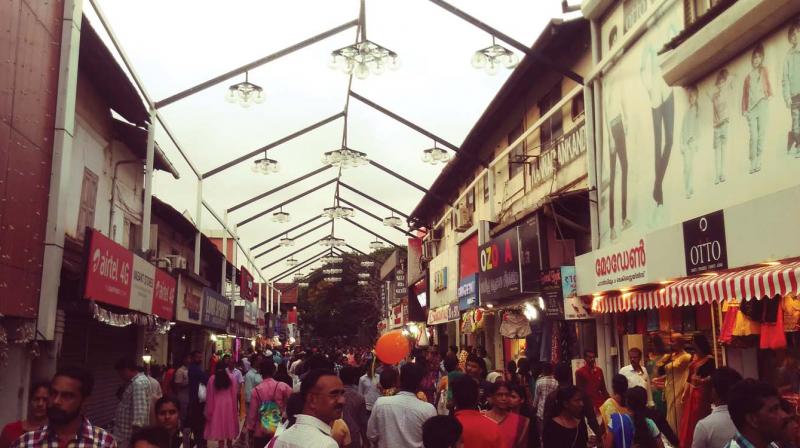Will Chala market in capital adorn Mittayi Theruvu's robe?

There are reports of a proposal to face-lift Chala market in Thiruvananthapuram the way the SM street has been renovated in Kozhikode. I travel between Trivandrum and Kozhikode frequently, and have the opportunity to visit these culturally vibrant markets of both the cities - Chala and Mittayi Theruvu/SM Street. While the latter is a retail hub for clothes, footwear, utensils, plastics and of course, sweets, the former caters to both whole sale and retail markets. Apart from their shared history of being living heritage, Chala and SM Street differ significantly in terms of street typology, urban morphology, economics and social fabric.
Historical sites mark moments of departure and arrival simultaneously. They converse with us in languages of bygone era while breathing the present, through the crumbling walls and moulded crevices. They are points of reference that constantly tell us who we were, how did we evolve and what have we become; they hold the collective memory of a people. In that context, urban market squares have played a significant role as places of exchange and as precincts of cultural identities. From Agora to chowks to floating markets of east Asia, these markets have witnessed an ever changing influx of population, housed different ethnic races, exchanged artifacts and, built/destroyed empires.
Thiruvananthapuram boasts of Chala as a medieval market boulevard believed to be built by Raja Kesava Dasa, Dewan of Travancore. SM Street is a traditional market which boasts of sweets and halwa shops run by Gujarati families who settled there during the time of Zamorins. Both the markets have undergone tremendous change in the past couple of centuries. They have adapted to the changing needs of our society, while continuing to offer us the right choice of goods. Today, these precincts face a common problem - worn out heritage buildings, poor quality of urban services, burgeoning vehicles outnumbering pedestrians on the narrow lanes that once carried animal-driven carts. The lanes are choked due to haphazard parking, unregulated hawking and pedestrians pushed to the margins.
Jan Gehl, renowned urbanist speaks in his book Cities for People, "Cities must urge urban planners and architects to reinforce pedestrianism as an integrated city policy to develop lively, safe, sustainable and healthy cities". Is pedestrianism a viable solutions to these living markets? A quick comparison between SM Street and Chala draws differences and similarities in terms of street typology and urban morphology. A renovated SM street with its cobble stone paving and fancy street lights regulate the entry of vehicles between 10 am to 10pm, when the entire street is left for pedestrians to occupy. The large mouth of the street adorned with the murals reminiscing Oru Theruvinte Kadha act as an assembly space where people gather, talk, perform or simply sip a 'Sharjah shake'. It leads to about half a kilometer stretch lined with informal vendors and retail shops.
Most of feeder roads to this main boulevard are kept open for vehicular traffic. Today, although it has transformed into a truly democratic space, finding a suitable parking lot close to the market is a nightmare for visitors. Shopkeepers complain of difficulty in loading and unloading of goods. Chala on the other hand is slightly over a kilometer fed by lanes interspersed with both retail and whole sale markets, each street specialising in a kind of good. It is therefore a unique fabric that has road-side vendors, traditional community settlements, loading unloading spaces, abandoned buildings, age old godowns, vegetable and meat market, choked drains, all entwined into one another to form the precinct and its aesthetics. An understanding of the market as a precinct is necessary and critical while intervening with the main boulevard which acts as its backbone.
Pedestrianization of the boulevard can attract more visitors to Chala, only if the development strategies can integrate other built and open elements surrounding it. Moreover, shops in Chala are vulnerable to fires and the streets vulnerable to seasonal floods. Apart from a cosmetic surgery, only an integrated approach to development of this historical precinct can lead to sustainable solutions for Chala. The master plan of Chala, therefore, should take into consideration other important public spaces in Chala's vicinity such as Putharikandom maithanam, Gandhi park, the temple precinct, Attakkulangara Government School etc. A thorough mapping and grading of heritage structures should be undertaken. A regressive method of 'touch me not' approach towards heritage structures can only deteriorate this living heritage. Participation of the communities, shopkeepers,vendors and other users is fundamental. Community participation in the design process is critical for such development that are culturally delicate, living and vibrant.
Markets belong to vendors and buyers, therefore, primarily the plan should highlight their needs. A blind pedestrianization policy can cause more harm to Chala, which otherwise can be addressed through a re-design of the street sections which can incorporate pedestrians, vendors, retailers, utility ducts and other important services like fire fighting. Chala is a living heritage. Any development strategy for this precinct must re-define our aesthetic sensibilities. The strategies for future should embrace the conservative past and express the needs of the present through a well thought out participatory plan.
(Architect and urban planner based in Thiruvananthapuram. Co-founder, Studio Commune)

